I was given the task of extracting customer information from a database and I am stuck on the last part! I hope my explanation is sufficient to describe my problem and attempts.
Goal: Return one row per customer with their all phone number
The Problem: Each customer may have many phone numbers

Attempts:
SUBQUERY: Getting a "Subquery returning more than 1 row" error. This makes sense to me but I cannot insert a WHERE statement per customer
SELECT customer.Name, address.Street, address.City, address.State, address.Zip, customer.Contact, email.Address, customer.CTYPE,
(SELECT telephone.Number
FROM customer
LEFT JOIN customertelephone ON customer.CustomerID = customertelephone.CustomerID
LEFT JOIN telephone ON customertelephone.TelephoneID = telephone.TelephoneID
WHERE telephone.Type = "Main") as MainPhone
FROM `customer`
LEFT JOIN customeraddress ON customer.CustomerID = customeraddress.CustomerID
LEFT JOIN address ON customeraddress.AddressID = address.AddressID
LEFT JOIN customeremail ON customer.CustomerID = customeremail.CustomerID
LEFT JOIN email ON customeremail.EmailID = email.EMailID
LIMIT 100
LEFT JOIN: The query returns one row/customer/number, but I need each number in one row.
SELECT customer.Name, address.Street, address.City, address.State, address.Zip, customer.Contact, email.Address, customer.CTYPE, telephone.Number
FROM `customer`
LEFT JOIN customeraddress ON customer.CustomerID = customeraddress.CustomerID
LEFT JOIN address ON customeraddress.AddressID = address.AddressID
LEFT JOIN customeremail ON customer.CustomerID = customeremail.CustomerID
LEFT JOIN email ON customeremail.EmailID = email.EMailID
LEFT JOIN customertelephone ON customer.CustomerID = customertelephone.CustomerID
LEFT JOIN telephone ON customertelephone.TelephoneID = telephone.TelephoneID
LIMIT 100
GROUP BY: The query properly returns one row per customer, but only returns the first number.
SELECT customer.Name, address.Street, address.City, address.State, address.Zip, customer.Contact, email.Address, customer.CTYPE, telephone.Number
FROM `customer`
LEFT JOIN customeraddress ON customer.CustomerID = customeraddress.CustomerID
LEFT JOIN address ON customeraddress.AddressID = address.AddressID
LEFT JOIN customeremail ON customer.CustomerID = customeremail.CustomerID
LEFT JOIN email ON customeremail.EmailID = email.EMailID
LEFT JOIN customertelephone ON customer.CustomerID = customertelephone.CustomerID
LEFT JOIN telephone ON customertelephone.TelephoneID = telephone.TelephoneID
GROUP BY customer.CustomerID
LIMIT 100
How can I return one row per customer display each of their phone number in only one row?
Edit:
I just received some awesome help: group_concat does wonders! Now I am trying to format the query return properly.
Goal: Separate the values returned by GROUP_CONCAT into new fields
Current SQL Code:
SELECT customer.Name, address.Street, address.City, address.State, address.Zip, customer.Contact, email.Address, customer.CTYPE, GROUP_CONCAT(telephone.Number) as TelephoneNumbers, GROUP_CONCAT(telephone.Type) as Types
FROM `customer`
LEFT JOIN customeraddress ON customer.CustomerID = customeraddress.CustomerID
LEFT JOIN address ON customeraddress.AddressID = address.AddressID
LEFT JOIN customeremail ON customer.CustomerID = customeremail.CustomerID
LEFT JOIN email ON customeremail.EmailID = email.EMailID
LEFT JOIN customertelephone ON customer.CustomerID = customertelephone.CustomerID
LEFT JOIN telephone ON customertelephone.TelephoneID = telephone.TelephoneID
GROUP BY customer.CustomerID
Current result of GROUP_CONACT:
TelephoneNumbers Type
321-000-0000,321-000-0000 Main, Fax
321-001-0000 Mobile
What I am trying to achieve:
Main Fax Mobile
321-000-0000 321-000-0000 NULL
NULL NULL 321-001-0000
Attempts: WHERE statement in GROUP_CONCAT, which throws an error
GROUP_CONCAT(telephone.Number WHERE GROUP_CONCAT(telephone.Type) = "MAIN") as Main
Is it possible to even achieve this?
EDIT:
Final code (thank you user4829935!):
SELECT customer.Name, address.Street, address.City, address.State, address.Zip, customer.Contact, email.Address, customer.CTYPE, GROUP_CONCAT(tmain.Number) as Main, GROUP_CONCAT(tmobile.Number) as Mobile, GROUP_CONCAT(tfax.Number) as Fax
FROM `customer`
LEFT JOIN customeraddress ON customer.CustomerID = customeraddress.CustomerID
LEFT JOIN address ON customeraddress.AddressID = address.AddressID
LEFT JOIN customeremail ON customer.CustomerID = customeremail.CustomerID
LEFT JOIN email ON customeremail.EmailID = email.EMailID
LEFT JOIN customertelephone ON customer.CustomerID = customertelephone.CustomerID
LEFT JOIN telephone as tmain ON customertelephone.TelephoneID = tmain.TelephoneID AND tmain.type = 'Main'
LEFT JOIN telephone as tmobile ON customertelephone.TelephoneID = tmobile.TelephoneID AND tmobile.type = 'Mobile'
LEFT JOIN telephone as tfax ON customertelephone.TelephoneID = tfax.TelephoneID AND tfax.type = 'Fax'
GROUP BY customer.CustomerID